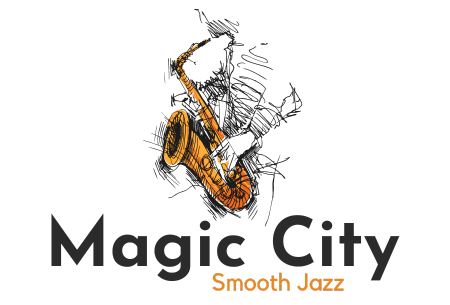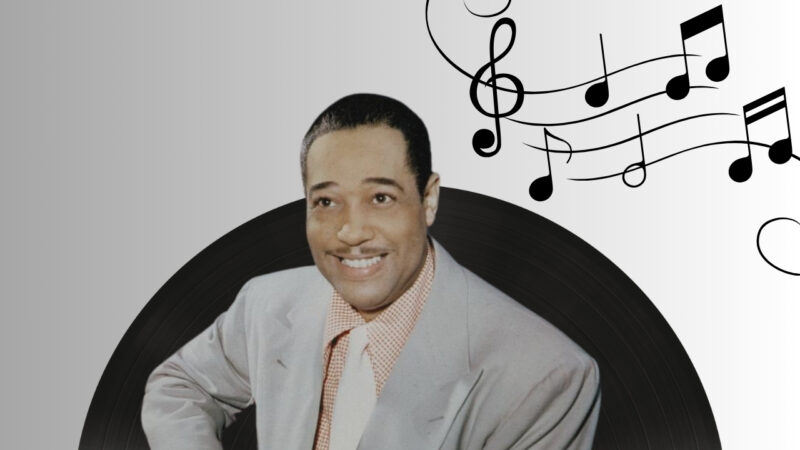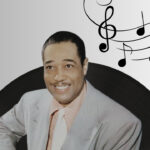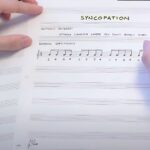Duke Ellington, a name synonymous with jazz, not only revolutionized the genre but also left an indelible mark on the fabric of American music. With a career that spanned over 50 years, Ellington composed thousands of pieces for the jazz orchestra, making him one of the most prolific and influential composers in the history of jazz music.
In this blog post, we’ll give you 10 of his most memorable songs, each showcasing his genius in a unique way. From the innovative orchestration of “Mood Indigo” to the poignant melody of “I Got It Bad (and That Ain’t Good),” you’ll enjoy, trust me!
1. Mood Indigo
“Mood Indigo” stands as a testament to Ellington’s inventive orchestration. By inverting the expected instrumental roles, he created an unusual timbre that has captivated listeners since its debut. The song features a clarinet playing at a lower register and a trombone at the top, a reversal of their traditional sounds.
This masterpiece not only showcases Ellington’s skill as a composer but also his ability to paint with sound, creating a mood that is both melancholic and deeply beautiful.
To truly appreciate the ambiance that nurtures this genre, exploring esteemed venues dedicated to jazz performances can offer a deeper connection to its essence. Among such places, Los Angeles hosts some of the most iconic spots where the spirit of jazz is alive and thriving
2. It Don’t Mean a Thing
Capturing the essence of the 1930s Swing era, “It Don’t Mean a Thing (If It Ain’t Got That Swing)” is an exuberant celebration of rhythm and energy. The song emphasizes the importance of feeling and swing in jazz, asserting that technical prowess means nothing without soul.
This track remains a timeless reminder of the era when jazz was the heartbeat of America, encouraging listeners to find the joy and swing in their own lives.
3. Caravan
“Caravan” is a mesmerizing piece that incorporates Afro-Latin and Cuban influences, showcasing Ellington’s ability to blend different musical traditions into something entirely new. Co-composed by trombonist Juan Tizol, the song is a classic example of the “Spanish tinge” that Jelly Roll Morton claimed was essential to jazz.
“Caravan” invites listeners on a journey, its exotic melody and rhythm conjuring images of distant lands and adventures.
4. Prelude to a Kiss
With “Prelude to a Kiss,” Ellington marked a stylistic departure, embracing complex, chromatic sounds and a meditative feel. This song moves away from the upbeat tempo of swing to explore more introspective and nuanced emotional landscapes.
Its sophisticated harmony and melody reflect Ellington’s deep musical knowledge and his ability to convey profound feelings through composition.
5. Cotton Tail
Based on George Gershwin’s “I Got Rhythm,” “Cotton Tail” is an uptempo number that features a notable tenor solo by Ben Webster. This song exemplifies the Blanton-Webster band era of Ellington’s orchestra, showcasing the innovative and energetic style that defined this period.
“Cotton Tail” is a celebration of rhythm and improvisation, a piece that continues to inspire jazz musicians today.
6. C Jam Blues
“C Jam Blues” is a testament to Ellington’s roots in the blues. With its simple two-note melody, the song is accessible to musicians of all levels, making it a staple in jam sessions. Despite its simplicity, “C Jam Blues” captures the essence of the blues—its soulful depth and capacity to express the human experience.
This tune is a reminder of the foundational role of the blues in jazz music.
7. Come Sunday
Part of the ambitious “Black, Brown and Beige” suite, “Come Sunday” is a spiritual-style ballad that reflects on the history of African Americans. This deeply moving piece combines Ellington’s rich musical language with themes of hope and resilience.
“Come Sunday” stands as a powerful expression of Ellington’s social consciousness and his ability to weave complex narratives into his music.
8. Satin Doll
“Satin Doll” was a collaborative effort between Ellington and Billy Strayhorn, his long-time collaborator. This song became a staple closing number for Ellington’s concerts, beloved for its catchy melody and sophisticated charm.
“Satin Doll” exemplifies the seamless partnership between Ellington and Strayhorn, a relationship that produced some of the most iconic music in jazz history.
9. I Got It Bad (and That Ain’t Good)
This song of unrequited love is closely associated with saxophonist Johnny Hodges, whose expressive lead alto tone brings the melody to life. “I Got It Bad (and That Ain’t Good)” showcases Ellington’s ability to craft songs that speak directly to the heart, exploring the nuances of love and longing with sensitivity and depth.
10. Never No Lament
Originally an instrumental titled “Never No Lament,” the song became widely known as “Don’t Get Around Much Anymore” after Bob Russell added lyrics. This song reflects a rejected lover’s perspective, combining Ellington’s sophisticated musicality with poignant storytelling.
It remains a favorite among jazz enthusiasts and performers alike, a testament to Ellington’s enduring influence on the genre.
FAQs
Did Duke Ellington only Compose Music for Jazz Ensembles?
No, he did not. Although he is best known for his work in jazz, Ellington also composed music for solo piano, orchestras, and various other ensembles. He was a versatile musician whose work spanned multiple genres, including classical music. His “Black, Brown and Beige” suite, for example, is a significant work that blends jazz with symphonic elements.
How Did Duke Ellington’s Early Life Influence His Music Career?
His early life in Washington D.C. played a crucial role in shaping his music career. Growing up in a middle-class African-American family, Ellington was exposed to the rich cultural heritage of his community, including its music. His parents were both pianists, and Ellington began taking piano lessons at the age of seven.
The vibrant music scene in Washington D.C., along with his family’s musical background, deeply influenced his passion for music and his future career as a jazz musician.
What Was the Significance of The Cotton Club to Duke Ellington’s Career?
The Cotton Club was significant to Duke Ellington’s career as it provided him with a major platform to showcase his music. Located in Harlem, New York, the Cotton Club was one of the most famous nightclubs of the 1920s and 1930s. Ellington’s orchestra became the house band in 1927, which significantly raised his profile and helped him reach a wider audience.
The club’s national radio broadcasts gave Ellington national exposure, contributing to his rising fame.
How Did Duke Ellington View the Term “jazz”?
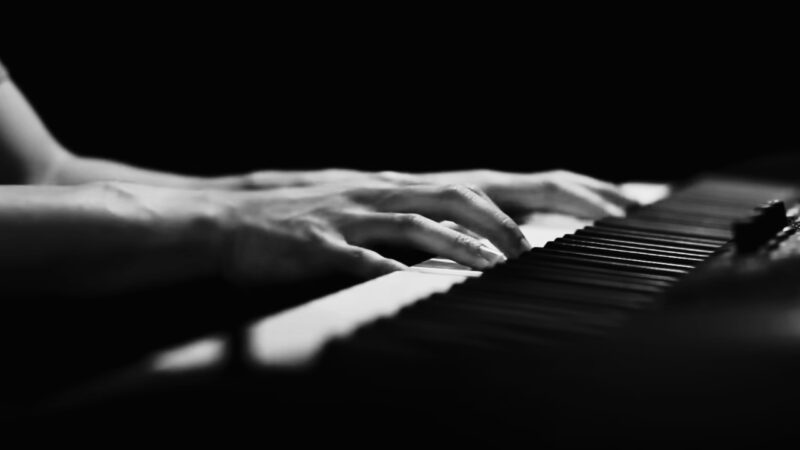
He had a complex relationship with the term “jazz.” He often felt that the label was too restrictive for the wide range of music he composed and performed. Ellington preferred to describe his music as “American Music” rather than jazz, as he believed his work transcended the conventional boundaries of jazz.
He was known to say that there are only two types of music: good music and the other kind.
Can You Name a Piece by Duke Ellington that Was Influenced by Classical Music?
One of his pieces that was influenced by classical music is “Black, Brown and Beige.” This suite, premiered at Carnegie Hall in 1943, was Ellington’s ambitious attempt to blend jazz with classical music forms.
It was a reflection of African American history and culture, presented in a format that was reminiscent of a classical symphony, with different movements representing different aspects of the African American experience.
Did Duke Ellington Collaborate with Other Famous Musicians?
Yes, he collaborated with many famous musicians throughout his career. Some of his notable collaborations include working with Louis Armstrong, Ella Fitzgerald, and John Coltrane. These collaborations often resulted in recordings that are considered classics in the jazz genre.
Ellington’s ability to collaborate effectively with other musicians was one of the hallmarks of his career, showcasing his versatility and openness to different musical ideas and styles.
Summary
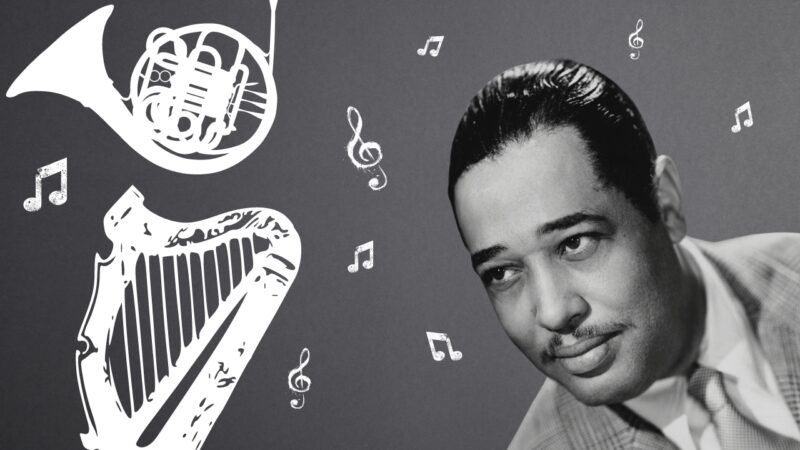
Duke Ellington’s music transcends time and genre, embodying the spirit of innovation and the depth of human emotion. These 10 songs are just a glimpse into his vast repertoire, each piece a world of its own, brimming with creativity, emotion, and unparalleled musical genius.
Ellington’s legacy is not just in the notes he wrote but in the lives he touched with his music. As we continue to listen and be moved by his compositions, Duke Ellington’s place as a titan of jazz is forever secured.
